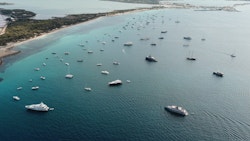Energy Observer discovers the yachts of the future
A little more than 52,000 super yachts are navigating around the planet. The term “super yacht” describes luxury vessels over 24 meters long for private or commercial use. In terms of fine-particle emissions, this fleet represents the equivalent of about 520,000,000 cars, or half of all the world’s automobiles.

Another significant observation: yacht-owners are gregarious. Be in summer in the Mediterranean or winter in the arch of the Antilles, these yachts cluster together in well-known sites like Saint-Tropez, Monaco, Porto Cervo, Palma, Ibiza, Mykonos, Saint Barthelemy, and the Virgin Islands.
“In the summer in Saint-Tropez, all the boats arrive and leave at the same time.” observes. They cause enormous amounts of pollution. Arriving from the sea, you can’t miss the cloud that floats above the gulf of Saint-Tropez. You could think the vacationer’s cars were to blame. But it’s not true. Today, three out of four cars are equipped with catalytic converters.”

Jérémie Lagarrigue
Comfort is the driving force of super yachts
And paradoxically, this exhaust-gas filtration technology still hasn’t been implemented in pleasure cruising.
But the wheels are turning. A large number of yacht-owners are saying they are now ready to invest in innovation linked to new energy sources. A new cap was set about 18 months ago, no doubt linked to the rising cost of hydrocarbons.
“The world of super yachts is very comfort-oriented. Until now, owners hadn’t really caught on that well-being can also come from innovation and environmental comfort. The message has evolved. Now we hear: If it doesn’t involve too many changes and even if it’s a little more expensive, I’m ready to invest in “green” technology.”

Energy Observer discovers the yachts of the future
Concretely, this means the boats are being refitted with environmental technologies. Recently, there is less reticence to begin work that confines the boat to the docks. Refits will allow for savings on fuel while also improving image. “I don’t know how this started, but it’s a reality” says the specialist.
Hybrid propulsion systems are appearing, always motivated by comfort. “Actually, we are talking about parallel hybrid systems, mainly for electric pod drives” confirms the Innovation Director of Enata Industries. “These innovations eliminate vibration, and free up more storage space. ”
And incidentally, it’s comfort that will serve as the lever to push this technological and energetic transition. “Customers are now specifically asking for hydrogen generators to supply electricity on board. Even if the cost is much higher, they are doing it because the biggest problems on boats are the noise and the smell of gasoline. On the other hand, solar power was never adopted because a boat is, first and foremost, an emotional purchase and we still haven’t figured out how to make an esthetic solar panel. ”
Optimizing hulls and new appendices
But, in the near future, hydrogen generators should also find their place in propulsion. Combined with hull evolutions and new rudders, like the foils that have already appeared. “We’re still focused on the idea of improving comfort, but we’re also making an effort to reduce fuel consumption. Foils are one solution, that also offer a huge boost to personal image as you cruise at helm of a flying boat, especially since a 10-meter boat with a foil will offer the same comfort experience as a submerged-hull boat measuring over 20 meters.“
But we shouldn’t get carried away, we aren’t yet ready to make a 40-meter boat with all the on-board comforts fly. Nonetheless, the “foil solution” will alleviate hulls and improve comfort at sea.
Solutions for clean energy production are also being developed, such as the flywheels that can be found in certain watches. People are imagining ways to capitalize on a boat’s movements and transform them into energy.
And we are already thinking about the future’s future. Ideas developed during the cold war are resurfacing. Ekranoplans, vehicles that are a cross between a boat and an airplane, that take advantage of ground effects, are under construction.

Energy Observer discovers the yachts of the future
Key figures
- A 345-meter ocean liner, with a power of 157,000 hp, represents the equivalent of 1,000,000 cars in terms of micro-particle emissions.
- A 180-meter ferry, with 60,000 hp, emits the same amount of micro-particles as 400,000 cars.
- A 40-meter yacht, with 1,500 horsepower, is equal to 10,000 cars in terms of micro-particle emissions.